Disability is a complex phenomenon representing an interaction between one's physical impairments, the activities they need to perform, and the architectural barriers within the space in which this situation occurs. The terminology and jargon used for disabilities evolves regularly whereas, "handicapped" is no longer acceptable. It is no longer merely a description of intellectual or physical impairments. Each individual with similar impairments describes his or her limitations differently. The blind don't experience their world the same as a person with deafness and so on. Physically challenged has become the more socially accepted description of a person with an impairment.

Physical limitations affect many more people than the daily users of walkers and wheelchairs. Many members of our life experienced or elder society have significant problems in dealing with their home environment. Today's conventional building standards conflict with most people's accessibility when you consider our created architectural barriers concerning cabinetry and door opening widths, individual strength, range of motion, movement, manual dexterity, balance, and coordination . This has brought about the need for handicap bathrooms. Once the demands of our built environment exceed their capacities we become excluded from a room or even the entire home. The building world must work in unison to be sure the entire living environment meets basic needs in addition to affordability and structural integrity for the consumer and home owner. Austin handicap remodeling is imperative considering bathroom remodeling includes both the home and the components within the home being accessible to all inhabitants. Privacy, sense of belonging, sense of control, and the sense of safety and security make up the quality of life for any home and should be considered for any design.
Designing for specific physical conditions will lessen the impact of say arthritis, restricted mobility, or loss of vision by using a combinations of products, concepts, and techniques. A trained CAPS specialist is able to identify the day to day problems weighing on those with health limitations. If you are considering an aging in place remodel for your home don't just contact any local remodeler in your area and expect a satisfactory accessible home modification. A professional design/build accessibility project can only be created for your specific needs by a qualified home remodeler having a nationally accepted CAPS certification. This credential is backed by the NAHB. Only a CAPS home remodeler possesses the specific knowledge that will insure a successful outcome for your aging in place project and what's more, keep you in your home.
The costs involved for handicap home modifications in Austin are really dictated by the amount of barrier free accessibility required by the person needing the assistance to be safe. Comfort and safety for the home's inhabitants are key issues when designing an accessibility remodel. Most homeowners nationally spend between $3,800 and $14,000 with a mean average expense of $7,500. This cost again is based on the individual home modifications providing the greatest safety for those in need.
Falls and slips are among the most common causes causes of injury to senior and elderly people requiring disability access remodeling. Smooth surfaces in combination with wet areas make the bathroom one of the most dangerous areas within the home. It is of paramount importance that the bathroom be updated providing safety for any person with limited mobility or the elderly. If you are on a tight budget and can only afford a few modifications, the bathroom is the first place to begin an accessibility remodel. The most basic improvements to enhance safety issues are fairly inexpensive.
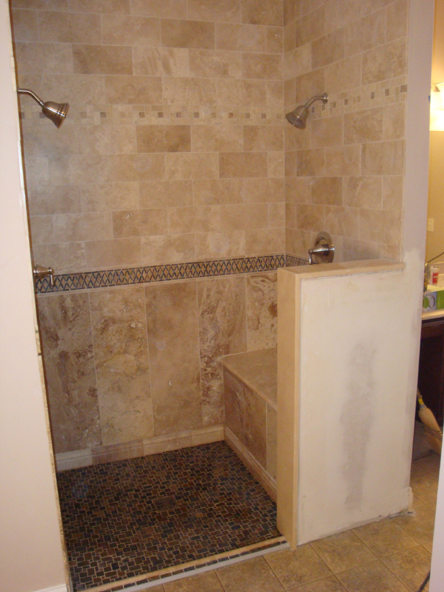

1. Vanity Sink Accessibility
Wheelchair Accessible bathrooms today contain stylish ADA vanities set at a universal height of 34 inches with clear knee spaces. Plan on 27 inches of vertical clearance for a wheelchair. The sink faucets must be easily controlled by either wrist handles or levers. The faucets can be fitted on the side of the sink to make them easier to reach. Or install infra-red faucets that detect motion. Hang the mirror low enough for a seated person to see themselves, and tip the top of the mirror out. Bathroom vanities with universal height cabinet tops and open knee spaces are taking over the marketplace. These new residential vanities do not need to look institutional. They can be designed like any other piece of fine furniture. Scalding must be guarded against by using either insulating pipe wrap or a removable panel for the plumbing.
2. Toilet Accessibility
Toilets are available in comfort heights eliminating the deep knee bend needed for seating. Grab bars should be installed on at least both sides of the toilet. Ideally, the toilet should be positioned between two support bars 36 inches apart. A toilet seat 17 inches off the floor is a more comfortable height for everyone. Creating a toilet within an open area and not a closet is much more accessible. Elevated or special toilet seats are available with a heat feature and some have the ability to self close or have a night light. A more expensive bidet/toilet is available but an add on bidet attachment to a regular toilet can be handy.
3. Bathing Facilities
Curbless roll in showers that are 5 feet wide and 3 feet deep having a 36" clear entrance are advised for everyone. The shower should contain at least a shower wand on a sliding bar for varying heights of use along with a regular shower head and control if desired. Installing fixtures with a scald guard or lowering the temperature at the water heater is a must to prevent burns. Folding seats in the shower are useful if caretakers are ever involved and they are much safer than a free standing shower seat which can fall over. Grab bars around the bath and especially in the shower should be used while non slip floor covering should always be considered. Walk in tubs are also a consideration but some people get chilled while the tub is draining. Install the slider bar for the hand held shower hose and head 4 feet off the floor so that the head can slide up to 6 feet high. Always use a shower valve that is thermostatically controlled and pressure-balanced to prevent scalds. If you desire a full body wash, you can include a regular shower head as well.
4. Safety and Accessibility
Always choose fixtures and fittings that are easy to control with a single hand motion or a closed fist. Motion controlled sensor fixtures are also a possibility when specifying finishes. Provide easily accessible storage compartments with pull out shelving eliminating architectural barriers by not using doors on the cabinetry. Always consider the individual needs of the occupant and find the best placement of any reachable items within their reach distance of 24". Fully consider where the best access is for all accessories such as robe hooks, towel bars, paper dispensers, soap dishes, toothbrush holders, shower shelves. The distances and clearances required will be dictated by the user and not by an accepted general outline. With falls in the wet area of the bathroom being such a great concern, a non slip tile floor should be installed without placing loose rugs in the general area. All doors should have levers instead of door knobs. The Americans with Disabilities Act requires a 5-foot turning radius for a wheelchair. But if space is tight, remodelers may be able to make do with less. "(The 5-foor turning radius) may not always be needed, especially with an electric chair, which will easily turn in a tighter space.
5. Lighting
Natural lighting is always better for anyone using the bath. Adequate task lighting in the shower, dressing area, and vanity vicinity should be installed. Lowered switches at around 48" above the floor in reaching distance should control all the lighting. You can install switches with a push button or large toggle that doesn't require a pinching motion to turn on and off. Outlets that are ground protected should be installed at 18" above the floor.

Aging in place home modifications are available through T-Square Company. Each design/build situation will be customized to fit your personal needs. Call 512-444-0097 today to begin the accessible second chapter of your life while remaining safe and secure in your existing home. CAPS 1636580
Tags:
ADA accessible,
ADA bathroom cabinets accessible routes,
aging in place home modifications,
wheelchair accessible remodeling,
CAPS certified remodeling in Austin,
ADA compliance,
disability bathroom remodels,
accessible home remodeling,
Universal Design,,
Austin bath remodeling,
Austin bathroom remodeling,
aging in place design,,
disability home modifications in Austin,
Austin elder construction,
handicap remodeling contractors,
bathroom modifications for disabled,
home improvements Austin,,
accessibility remodelers in Austin,
ADA remodeling Austin, Texas,
ADA bathroom Austin, Texas,
roll in showers,
accessibility designs Austin Texas,
disability access bathrooms Austin
The ADA refers to the Americans With Disability Act developed in the 1990's to be sure any person with a disability has equal access to all public facilities and spaces. There are no restricted codes or regulations to increase accessibility for private residences concerning residential bathrooms or disability access baths. However, the published guidelines for ADA accessibility concerning public buildings and facilities is a great resource and starting point for ideas on how to make any home safer and easier to live in. Using the ADA guidelines, every design is customized around the end users abilities and body size. Homes can become more accessible through bathroom remodels to people as they age or become disabled from an accident or chronic disease. Many of these published guidelines for wheelchair accessible remodeling, particularly requirements for corridor and door widths, safety bars and proper access to different types of facilities can go a long way in extending the amount of time an elderly or physically impaired individual is able to live independently. This is the primary goal for ADA remodeling.
Many people suddenly find themselves needing accessible homes for themselves or family members. When mobility becomes an issue for any homeowner, regardless of age, the question arises concerning physically moving to a different home with a bathroom that is more accessible. Preparing for one of those highly likely events involving someone in your home needing room modifications for even a short time while recovering from surgery is surely a smart move and is the essence of proactively planning to Age in Place. Solving Aging in Place issues will soon become the number one challenge concerning the present obsolete housing inventory in our country plus the fact that people are living longer. The situation will only become ever more expanding in time.
When our homes were first purchased, they satisfied the particular family needs of the day. These homes represented an absolute castle in the world of their owners in which to prepare for a day and they also acted as a retreat from life's tough interactions. They housed our families, our memories, and our stuff. They represented a place where we could be ourselves. Then something happens in life changing those family needs. Unfortunately, these homes have always been exempt from any and all of the accessibility regulations mentioned by the ADA.
In fact, there are approximately 30 million Americans using wheelchairs and the number of people who need accessible homes will continue to increase as disabled and aging people are finding more ways to remain living in their homes. One important way to increase independent living is making a home accessible to an individuals personal needs. Home modifications can increase safety, accessibility, and independence for people who want to live independently. T-Square Company, building in Austin, Texas, incorporates the ADA rules in all their design/build projects, but in a customized manner. All disability home remodeling or disability bath remodels in Austin must be done considering all the data provided by the client, his or her family, and any caretakers involved. Aging in Place design should always be carried out by a seasoned Aging in Place specialist like T-Square Company.
The new evolving concept known as Universal Design and specialized handicap remodeling contractors for home remodeling is catching on nationwide and has been for several years as a sign of the times. Universal Design techniques used in building makes a home more accessible to all regardless of their mobility or adaptive abilities, and seamlessly segues into what is needed for Aging in Place. An evolution of new products used for disability home modifications is making homes more accessible and has finally come about in the remodeling industry. These new advances in accessible home remodeling not only keep the living environments safer but will not compromise the home's aesthetics. They blend into the existing home and do not appear institutional. Universal Design principles never call attention to the family member needing them the most. In fact, there are many benefits to using Universal Design techniques, including potential use by aging family members, added resale value, and the fact that you'll be creating a space that can be used by anyone who visits your home, regardless of their range of abilities. Simple Universal Design updates for Aging in Place home modifications and handicap bathroom accessibility can include adding grab bars or handrails throughout the home, adding a seat within the roll-in-shower, lowering upper cabinets and multiple height counter tops, adding non-slip flooring, widening hallways or installing stair lifts, and widening doors. You might also consider lowering light switches and thermostats and installing easier to use door knobs. You should provide a clear barrier-free path or accessible route to the most visited areas of your home as recommended by the ADA. People who are interested in Aging in Place home improvements are now looking for a level entry into their home along with the maneuverability that a more open floor plan having greater clear unobstructed floor space presents. They desire flat floors without transitions requiring steps or stairs to move around. Ramps having a correct 1:12 slope can be used to get them up to the level floor space at the exterior entries or the garage access. ADA compliant kitchen cabinets and ADA bathroom cabinets in handicap bathrooms will more than likely come into play to complete any accessible home remodeling project.
Most aging baby boomers prefer one-story homes in which to Age in Place and this has become a primary reason to relocate versus a remodel. They are looking for an accessible master suite and kitchen located on the same floor. However, some developments mandate building two-story homes. The above requirement can be easily met by placing the guest bedrooms and accompanying bath upstairs. If the master suite for any reason needs to be upstairs, closets can be stacked between floors to house a future elevator installation.





The National Association of Home Builders, in partnership with the AARP and Home Innovation Research Labs, created the CAPS program, which includes training and education on the technical, business management and customer service skills essential to compete in the fastest growing segment of the residential remodeling industry--home modifications for Aging in Place and ADA accessibility in Austin, Texas. David L. Traut, CAPS the owner and president of T-Square Company in Austin, Texas is one of the select group of professionals nationwide to earn the Certified Aging in Place Specialist (CAPS) designation, identifying him as a home remodeler and builder with the skills and knowledge necessary to remodel or modify a home to meet the unique needs of the older population, disabled owners, or their visitors. Additionally, he is certified in Universal Design in the United States and Australia. David has recently published a book called "Age in Place at Home: Adapting the Home Environment For All Generations". The book explains the importance of Universal Design in building and is available through Amazon.
Tags:
ADA accessible,
accessible routes,
ADA bathroom cabinets accessible routes,
barrier free access,
aging in place remodeling,
aging in place home modifications,
aging in place,
ADA remodeling,
ADA compliance,
disability bathroom remodels,
accessibility home remodeling in Austin,
CAPS professional in Austin,
CAPS certification holder in Austin,
accessible home remodeling,
CAPS remodeling techniques,
Universal Design,,
Austin bathroom remodel,
disability home remodeling in Austin,
bathroom modifications for elderly,
aging in place specialist,
aging in place services,
aging in place design,,
elder construction,
certified aging in place specialist,
disability home modifications in Austin,
Austin elder construction,
handicap home modifications for disabled,
handicap accessibility,
bathroom modifications for disabled,
bathroom accessibility remodels in Austin,
accessibility remodelers in Austin,
ADA bathroom Austin, Texas,
accessibility designs Austin Texas,
handicap bathrooms,
ADA Austin
Just what are accessible homes of Austin? Accessible homes of Austin provide homeowners with a means to stay healthy, independent, and safe. Architectural barriers have either been removed during elder construction or were never a part of the design for increasing accessibility. The accessible home stands as the defined course to the universal designed home.
 The accessible home represents a wonderful place where people with disabilities can live comfortably and safely.
The accessible home represents a wonderful place where people with disabilities can live comfortably and safely.
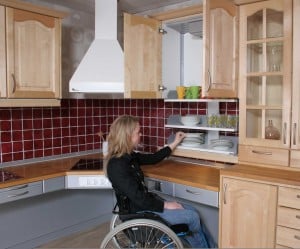


Everyone ages differently and has different needs and wants. The factors that constitute the aging in place market for all individuals are based on a persons genetic makeup, their lifestyle including the choices they have made while living their life, and their environment. These factors have brought about the need for universal design. This is the design of products, services, and environments that are usable by as many people as possible regardless of age, ability, or situation without the need for adaptation or specialized alterations. It provides for the greatest safety and access for any home guests or occupants and is undetectable when done well. Since so very few homes share the accessibility offered by universal design, to satisfy the needs of a particular household member brought about by an accident, an illness, or simply the aging process there will always be a need for customized accessibility features. This will be accomplished by a CAPS accredited remodeling professional producing a truly functional design. This same competent design/build home remodeling company who understands and practices aging in place home modifications in Austin should carry out the work to fit the design and insure your safety and accessibility. A certified aging in place specialist will be listed in Washington on the NAHB CAPS listing.

There are three segments that are served within the aging in place marketplace. The first segment includes those clients without urgent needs. They have no immediate health issues and simply have a preference for universal design techniques. The second segment focuses on a group of homeowners with progressive health condition needs. These people have a chronic or progressive conditions like MS requiring special modifications to their home allowing them to age in place. This group of people will face a time of urgency at some point in their lives as their mobility needs evolve. The third sector involves those people who have undergone traumatic health changes that necessitates immediate modifications to their home in order to age in place. Only aging in place home remodeling in Austin can accomplish the home modifications for all three sector's needs mentioned above. As our society evolves away from institutionalized care, making a home more comfortable for both older adults and their visitors can have an immediate benefit on the comfort and lifestyle of the adult child.
The concept of the accessible home has evolved beyond the basic grab bars and ramps to one in which accessibility is built into the basic design. Universal design makes living in a home easier for people of all ages and abilities.
Accessible design can be both beautiful and functional and never needs to have any institutional appearance. As our aging baby boomer population ages, the need for accessibility in the home is becoming ever more important. Our new way of viewing the basic home in our society and our antiquated architecture is giving way to a revolution in home design. Ordinary homeowners with extraordinary challenges can partner up with
CAPS design professionals, architects, and their own families to create homes to restore capabilities, independence, and grace to daily living.
Tweet this! The reality is that accessible homes will be needed at sometime in all our lives whether for ourselves, our family members, or our guests. This in itself defines the Aging in Place concept and it's associated CAPS accreditation, which is a nationally registered credential offered through the NAHB. It's function is not only to keep people in their homes longer but to provide safety and independence to all homeowners.
As in the kitchen in the above photograph, the
accessible kitchen is comfortably sized for a clear turning radius and to avoid backing up for an approach. It must be tailored to the homeowner's abilities and interests. Pull out shelves expand work spaces at activity centers, while roll under access is given underneath the work areas for the stove, prep, and service areas. A higher and deeper base cabinet kick space area provides better forward wheel clearance for the wheelchair to enable the user to get closer to the cabinet work space for increased reach distances. Raised dishwashers offer easier access to dishes and lowered microwaves and other appliances solve other reach distance problems making it easier to live with a disability. Open storage areas without doors to interfere with access is definitely a better solution. A successfully designed kitchen isn't about cabinet style or the composition of the counter top and is more about the ways the design can support the user's personal needs.
Human problems must be solved using correct designs. People who have become seriously injured, people living with a debilitating disease, people with sensory limitations or intellectual limitations, and last but not least the people who are planning to stay in their homes for as long as possible all need accessible homes. The need for dealing with disabilities during
elder construction empowers us all to ensure that we create environments wherein people can function effectively. How are you planning for your future when it concerns your home?
Aging in place home modifications are available through T-Square Company in the Austin area. We have an A plus rating with the local BBB and have over 30 years of remodeling experience. We are additionally a certified aging in place specialist offering complete
aging in place services. Each design/build situation will be customized to fit your personal needs increasing your accessibility. Call 512-444-0097 today to begin the accessible second chapter of your life while remaining safe and secure in your existing home. CAPS #1636580
David L. Traut, CAPS
Tags:
Austin,
Texas,
how-to,
ADA compliant kitchen cabinets,
ADA bathroom cabinets accessible routes,
CAPS,
aging in place home modifications,
aging in place home improvements in Austin,
wheelchair accessible baths and kitchens,
handicap home modifications,
ADA bathroom cabinets,
disability bathroom remodels,
handicap accessible bathrooms,
aging in place construction,
accessibility home remodeling in Austin,
Austin bathroom remodel,
Austin kitchen remodeling,
Austin kitchen remodel
According to the Joint Center for Housing Studies (JCHS) at Harvard University, the nation's housing inventory is in no shape to accommodate the 70% increase in the number of Americans aged 50 and over that will occur between 2000 and 2030. Over the next two decades, more than 27.7 million people will join the 50 and over age group. Most of this increase will be among the population aged 65 and over which is projected to surge 65% by 2030.

Universal design and aging in place design and services in Austin have finally taken hold in the residential remodeling industry. The current housing inventory doesn't offer the features needed for safety and accessibility in the numbers needed to accommodate the growing demand. It is ultimately up to the homeowners and their families to plan for future housing needs. Just what are the most important design issues regarding aging in place home modifications in Austin?

To begin with, the JCHS data showed that one of the top priorities with aging in place consumers is low maintenance. They want their houses to look great and require as little maintenance as possible. There is a minimal need for landscaping and outdoor upkeep, exteriors that require periodic painting, and a preference for newer houses rather than older ones where things don't break down as easily. These are the main reasons why the aging population considers moving. However, the kitchen and bath in existing homes are the two main areas most referenced when considering CAPS certified remodeling improvements.

People who are interested in aging in place home improvements and elder living solutions are now looking for a level entry into their home alongwith the maneuverability that a more open floor plan having greater clear unobstructed floor space presents. They desire flat floors without transitions requiring steps or stairs to move around. Ramps having a correct 1:12 slope can be used to get them up to the level floor space at the exterior entries or the garage access.
Most aging baby boomers prefer one story homes in which to age in place and this has become a primary reason to relocate versus a remodel. They are looking for an accessible master suit and kitchen located on the same floor. However, some developments mandate building two story homes. The above requirement can be easily met by placing the guest bedrooms and accompanying bath upstairs. If the master suite for any reason needs to be upstairs, closets can be stacked between floors to house a future elevator installation.

Kitchens have evolved because fewer cabinets are needed within the more open designs. Fewer wall cabinets are needed because of personal reach limitations. For those that are used, they can be installed at 14" above the base cabinet work top instead of the standard 18" spacing. The cabinet top is now lowered by two inches and installed at a universal 34" height. This makes a net 6 inch lower installation height for the bottom of the wall cabinet. All types of cabinet inserts like pull out shelves and specialized drawers are now available for installation in both base and wall cabinets. These devices will certainly help solve the reach problem. Base cabinet kick spaces can be raised to 9" and deepened instead of the standard 4" to accommodate wheelchair access. Kneespaces can be incorporated into the design for roll under access at the sink, prep area, and cooktop.
The lack of bending motion and decreasing reach distances is changing the way we purchase and install appliances at comfortable heights. Placing dishwashers higher by a few inches to limit bending has become a reachable fad and the new height is changing the old look of our kitchens. Refridgerator drawers, dishwashing drawers, and double ovens that are no longer stacked are just a few changes within the present day appliance marketplace. Cooking ranges with the controls located on the front represents another metamorphosis helping with reach problems. Microwaves can be installed on the now lowered countertop or within the lowered base cabinet according to the consumers need for adequate reach.
The lack of doors represents a change in the cabinet market. The new open look lets homeowners access what is stored within the cabinet without an open door blocking their clear path for approach. No matter in what manner the doors are hung they always interfere with accessibility. The open cabinet look is seen in both the bath and kitchen.
Accessible bathrooms today contain stylish vanities set at a universal height of 34 inches with clear kneespaces. The sink faucets are easily controlled by either wrist handles or levers. Toilets are available in comfort heights eliminating the deep knee bend needed for seating. Toilet seats are available with a heat feature and some have the ability to self close or have a night light. Curbless roll in showers are advised for everyone. The shower should contain at least a shower wand on a sliding bar for varying heights of use alongwith a regular shower head and control if desired. Folding seats are useful if caretakers are ever involved. Grab bars around the bath and especially in the shower should be used while non slip floor covering should always be considered.

The National Association of Home Builders, in partnership with the AARP and Home Innovation Research Labs, created the CAPS program, which includes training and education on the technical, business management and customer service skills essential to compete in the fastest growing segment of the residential remodeling industry--home modifications for aging in place. David L. Traut CAPS owner of T-Square Company in Austin, Texas is one of the select group of professionals nationwide to earn the Certified Aging-In-Place Specialist (CAPS) designation, identifying him as a home remodeler and builder with the skills and knowledge necessary to remodel or modify a home to meet the unique needs of the older population, disabled owners or their visitors.
For additional information about the CAPS program, visit nahb.org/CAPS. For more information about T-Square Company, visit www.tsquareco.com or call 512-444-0097.
Tags:
ADA bathroom cabinets accessible routes,
aging in place home modifications,
wheelchair accessible remodeling,
wheelchair accessible baths and kitchens,
handicap home modifications,
CAPS certified remodeling in Austin,
accessibility home remodeling in Austin,
CAPS professional in Austin,
Universal Design,,
Austin bath remodel,,
Austin bathroom remodeling,
Austin bathroom remodel,
aging in place services,
aging in place design,,
elder construction,
certified aging in place specialist
Commercial bathroom remodeling Austin is supremely different than any fine bathroom upgrade involving a residential setting. You have to consider the needs of the general public and not simply the needs of a certain set of employees involved at working at a business. There are many guidelines and sets of rules to be considered. Compliance with these regulations will be acheived by first hiring an experienced commercial building contractor. Be aware that a true residential contractor normally does not possess the knowledge of the contractor operating within the commercial world of construction. He simply does not use nor is he confident with all the commercial rules. Meeting and understanding the ADA accessibility regulations as they pertain to all commercial buildings requires a certain skillset and experience. A commercial contractor will possess the knowledge of the building's structure and composition along with the experienced ways of altering the construction to bring it into compliance.
A completely serviceable special needs bathroom must contain an ADA accessible vanity. The vanity must be one with a clear underneath scald protected area having an unobstructed roll under capability for wheelchairs. A five foot turning radius allowing the wheelchair to maneuver an approach must also be associated with the ADA vanity. The area of travel will then be enhanced by an unobstructed clear accessible barrier free route dedicated to reaching the vanity.
Whether the job concerns ADA remodeling or new construction, commercial or residential, the end result will always be the same in aiding those who no longer or have never had the choice of a means of locomotion. Sometimes folks need a little help beyond the rest of us to be self sufficient and hold on to their dignity. That's when the clear accessible route comes into play. This designated route wil make it possible for those with special needs to enter through the front door and travel into any room of the structure without barriers like the bathroom.

There are basically two styles of ADA vanities that comply with an unobstructed roll under area below the sink. This capability has everything to do with both the water supply lines and the main waste line connecting the sink. There must be provisions made to protect the user from being scalded when coming into contact with any one of the plumbing pipes serving the sink. These connecting pipes may become heated merely by the water passing through them creating the problem. The open type model should always receive both waste and supply insulating jackets applied directly to the pipes providing protection for the wheelchair user. The closed model concealing the pipes will be equipted with a removable face or face board covering the pipes. This pipe concealing panel must be installed at the correct angle. This allows for the needed unobstructed legroom required for the user. The vanity can extend beyond the sink but the area containing the sink is required to have this roll under capability. This section of the vanity must not be any taller than 34 inches above the finished floor with sufficient lower clearance. Clear unobstructed reach distances around the countertop area must be observed. Any motion controlled sensors integrated into the various dispensing devices and/or plumbing fixtures throughout the restroom present a true hands free benefit to all the restroom users. If these aren't in the budget then at least wrist handles used for controlling the faucet can be incorporated into the design of the vanity. Furthermore, automatic flush valves should be used on all toilets and urinals that provide for hands free use.
Regardless of whether there are special needs people working within a commercial building or not, we are required by law to make all the common areas ADA accessible. Homes provide a different situation because the alterations are put in place for specific full time occupants. The barrier free accessible route put in place must be observed as a means of life safety and function. You just never know when a personal life changing situation can appear requiring help for those with special needs. If one does occur we do have the means to offer aid and safety to those who have become afflicted in some unfortunate way and to help preserve their personal dignity and independence.
A Typical Commercial Bathroom Layout Representing Better Accessibility
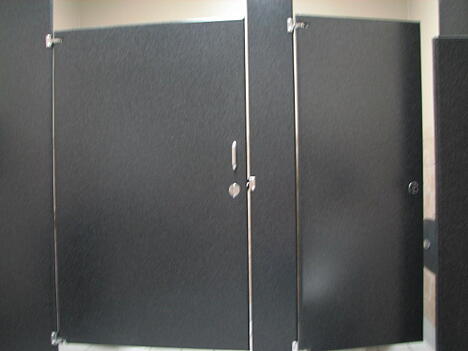

Tags:
Austin,
Texas,
ADA compliant kitchen cabinets,
Commercial Construction,
ADA accessible,
ADA bathroom cabinets accessible routes,
bathroom remodels,
ADA remodeling,
building professional,
ADA bathroom cabinets,
ADA compliance,
ADA vanities,
accessibility remodelers in Austin,
ADA remodeling Austin, Texas,
ADA bathroom Austin, Texas,
accessibility designs Austin Texas,
commercial ADA bathroom,
commercial ADA accessible vanitys,
commercial ADA accessible vanities,
commercial ADA vanities,
commercial bathroom remodeling
Life happens and your present way of going about it includes newly discovered physical barriers which were never an issue before. You've lost your mobility and are now forced to rely on a wheelchair for assistance at least for the present time. The maneuvering of familiar areas within your home you'd always taken for granted are now presenting barriers that are limiting your new means of mobility. Clear openings of 32" or greater, elevation changes steeper than 1:12, and being able to have access to all your home's facilities have been affected springing forth handicap remodeling. The removal of these home grown barriers that now disrupt your accessible route for handicap bathrooms in Austin, Texas needs to be done by a qualified building professional holding a CAPS certificate. Any ADA remodeling should comply with both ADA and local building code standards along with the TDLR guidelines.

Problems encountered while accessing your home when you are wheelchair bound generally begin before or at the front door. Given that you can reach the front porch approach without obstruction is a great start. The stairs leading onto the front porch are yet another matter all together. A correctly designed ramp having the correct slope can adequately solve this problem. The use of grab bars and any railings will be dictated by the ramp's design and the regulations involved. Once your safely upon the porch, your home's front door width can become an issue. Any entry door less than three feet in width will cause a problem in maintaining a required 32 inch clear entry way that starts the new accessible route within your home. Once inside the structure a new set of problems concerning your accessibility will be discovered.

An accessible bathroom for your convenience becomes the first issue. The disability access bathroom will be located within the accessible route. Any barriers encountered while approaching the bathroom entrance will need to be removed. The minimum clear widths have to be observed. This will include the bathroom door itself. Twenty four to twenty eight inch wide doors are commonly used during the construction of American homes for accessing the bathroom and must be widened during a bathroom transformation. Anything below three feet does not meet the clear 32 inch requirement mentioned above and will need to be altered for clearance of your wheelchair. This work may involve moving light switches. These alterations should be done by a licensed electrician assuring your safety.
Once inside the accessible bathroom you should try to maintain a five foot turning radius for your wheelchair if at all possible. You will need to have your plumbing facilities brought into compliance to enable your freedom and safety. Bathroom modifications for the disabled involve the use of grab bars within the tub or shower and around the toilet which can be very helpful insuring your safety for maneuverability. These should be installed at 34 inches above the finished floor to safeguard your use of them. Having roll under capability for the new 34" high ADA compliant vanity can be very helpful while you are in the wheelchair. Exact clearances should be complied with underneath the vanity. The proper safety equipment should be installed on the plumbing pipes that don't allow scalding of your legs. The toilet may need to be replaced providing a comfort level height for easier access. The handicap bath or roll in shower may need to be altered to become only a shower with roll in or possibly transfer capabilities. Roll in showers are always easier to deal with than handicap baths having walk in ability. However, these tubs are not for everyone especially those with dementia so do your homework before buying such an expensive addition to your bathroom. All of these changes must be done along the ADA guidelines for your safety.

The referenced door situation above will be true for any room in the house if you are to enter them barrier free. The kitchen, your bedroom, and any other rooms you require accessibility to enter could be affected. Even the closet door within your bedroom will need to be wide enough so that you can manage getting your clothes to dress. Any other bedrooms that you may need to enter with your wheelchair will need alterations.
The accessible kitchen is another story altogether. You will at least need the roll under capability as mentioned above at the sink. Upper kitchen cabinet heights may become an issue if you still plan to do meal preparations. No matter what you end up doing, make sure to hire an experienced building professional who understand the ADA guidelines for your well being.
Aging in place home modifications are available through T-Square Company in the Austin area. We have an A plus rating with the local BBB and have over 30 years of remodeling experience. We are additionally a certified aging in place specialist offering complete aging in place services. Each design/build situation will be customized to fit your personal needs increasing your accessibility. Call 512-444-0097 today to begin the accessible second chapter of your life while remaining safe and secure in your existing home. CAPS #1636580


Tags:
Austin,
Texas,
ADA compliant kitchen cabinets,
ADA accessible,
accessible routes,
ADA bathroom cabinets accessible routes,
barrier free access,
aging in place home modifications,
aging in place home improvements in Austin,
ADA remodeling,
ADA bathroom cabinets,
ADA compliance,
ADA kitchen cabinets,
accessibility home remodeling in Austin,
accessible home remodeling,
Austin bath remodeling,
Austin kitchen remodeling,
disability home remodeling in Austin,
aging in place specialist,
aging in place services,
aging in place design,,
elder construction,
handicap remodeling contractors in Austin,
independent living in Austin Texas,
handicap home modifications for disabled,
ADA vanities
A traditional home builder has never truly considered the special needs of the disabled or aging within any home design. Unfortunately the design emphasis is always put on aesthetics and takes for granted everyone's mobility. There certainly are no guarantees or clauses within any home's sales contract that will prevent our future personal life experiences from introducing us to at least a temporary disability. Accidents will always happen and you could find yourself having to utilize a wheelchair or walker to facilitate your independence for mobility. Limitations in our mobility or constantly changing needs experienced by both the disabled and the elderly have sprung a new dimension in construction known as ADA remodeling to accomplish increased kitchen and bathroom accessibility.


As we age, just maneuvering around within our home becomes more difficult. Some debilitating diseases slowly take over our bodies completely reducing mobility over time. The situation is complicated further once we are forced to use any device for increased mobility. That's when we find ourselves asking how we are to negotiate a set of stairs or a doorway that is too narrow to allow entry into a room or even the entire house. These types of overpowering circumstances can certainly make life terribly difficult to deal with at times. Who would ever have imagined that just passing through a doorway we had negotiated many times could now present such a problem in our life?
Designated accessible routes can be created by first hiring a knowledgeable residential construction contractor in Austin, Texas. The experienced builder you contract with must be skilled in both home remodeling and all ADA guidelines tom successfully accomplish disability bathroom remodeling in Austin. The noted accessible route will first provide ways to accomplish any elevation changes in your yard that once required only stairs leading up to your front door. A correctly angled ramp following ADA guidelines will help you gain access into the house. Maybe the front door itself needs to be widened or additionally equipped with an electronic opener.

Once inside, the accessible route will continue into all the rooms increasing their accessibility provided for by wheelchair remodeling. Kitchen upgrades and disability access bathrooms will provide roll under capability for wheelchairs at all sinks. A required underneath clearance and scalding protection below the sinks must be observed for the end user with special needs. The correct handles must be used controlling all sink faucets assisting those with limited mobility. Reach limits must not be exceeded above the new 34 inch high cabinet top. Roll in or transfer showers outfitted with hand held showers and adjustable slide bars can also be of assistance. Hallways need to be wide enough for wheelchair clearance and all entry doors at each room must be at least 36 inches wide for unobstructed entry. A clear and unobstructed wheelchair turning radius will be built into the design for increased accessibility to facilitate leaving a small rooms in the bathroom. Lowering the light switches in certain rooms may be a requirement to help with decreased mobility.
Your professional builder will be able to access the costs associated with the accessible route designed plus he must be able to lead you in the right direction for the available budget you have to spend for your ADA remodel. Your biggest and most important duty will be in qualifying the builder you choose. Remember that this special type of information is not common knowledge with all builders and remodelers. You must be sure he has both the experience and knowledge for understanding any and all of the ADA requirements that will most certainly increase your accessibility. If he uses the correct methodology, your lifestyle can become much more manageable and independent making adapting to life's changes far easier. Do your homework and don't depend on advise from others for guidance in solving your most personal problems in life.


Tags:
Austin,
Texas,
residential construction contractor,
how-to,
ADA accessible,
accessible routes,
ADA bathroom cabinets accessible routes,
ADA remodeling,
ADA bathroom cabinets,
disability bathroom remodels,
handicap accessible bathrooms,
aging in place construction,
accessibility home remodeling in Austin,
accessible home remodeling,
Austin bath remodeling,
Austin bath remodel,,
Austin bathroom remodeling,
Austin bathroom remodel,
aging in place specialist,
aging in place services,
aging in place design,,
certified aging in place specialist,
bathroom remodeling contractor Austin Texas,
bathroom remodeling Austin Texas,
bathroom modifications for disabled,
ADA vanities
A completely serviceable special needs bathroom must contain ADA vanities and the accessible route must be defined. The vanity must be one with a clear underneath scald protected area having an unobstructed roll under capability for wheelchairs. A five foot turning radius allowing the wheelchair to maneuver an approach must also be associated with the ADA vanity. The area of travel will then be enhanced by an unobstructed clear accessible barrier free route dedicated to reaching the vanity.

Whether the job concerns ADA remodeling or new construction, commercial or residential, the end result will always be the same in aiding those who no longer or have never had the choice of a means of locomotion. Sometimes folks need a little help beyond the rest of us to be self sufficient and hold on to their dignity. That's when the clear accessible route comes into play. This designated route will make it possible for those with special needs to enter through the front door and travel into any room of the structure without barriers especially entering the accessible bathroom.

There are basically two styles of ADA bathroom vanities that comply with an unobstructed roll under area below the sink. This capability has everything to do with both the water supply lines and the main waste line connecting the sink. There must be provisions made to protect the user from being scalded when coming into contact with any one of the plumbing pipes serving the sink. These connecting pipes may become heated merely by the water passing through them creating the problem. The open type model should always receive both waste and supply insulating jackets applied directly to the pipes providing protection for the wheelchair user. The closed model concealing the pipes will be equipped with a removable face or face board covering the pipes. This pipe concealing panel must be installed at the correct angle. This allows for the needed unobstructed legroom required for the user. The vanity can extend beyond the sink but the area containing the sink is required to have this roll under capability. This section of the vanity must not be any taller than 34 inches above the finished floor with sufficient lower clearance. Clear unobstructed reach distances around the countertop area must be observed. Any motion controlled sensors integrated into the various dispensing devices and/or plumbing fixtures throughout the restroom present a true hands free benefit to all the restroom users. If these aren't in the budget then at least wrist handles used for controlling the faucet can be incorporated into the design of the vanity. Furthermore, automatic flush valves should be used on all toilets and urinals that provide for hands free use.

An Example of the First Type of ADA Vanity Using Pipe Insulation and a Wrist Blade Handled Faucet
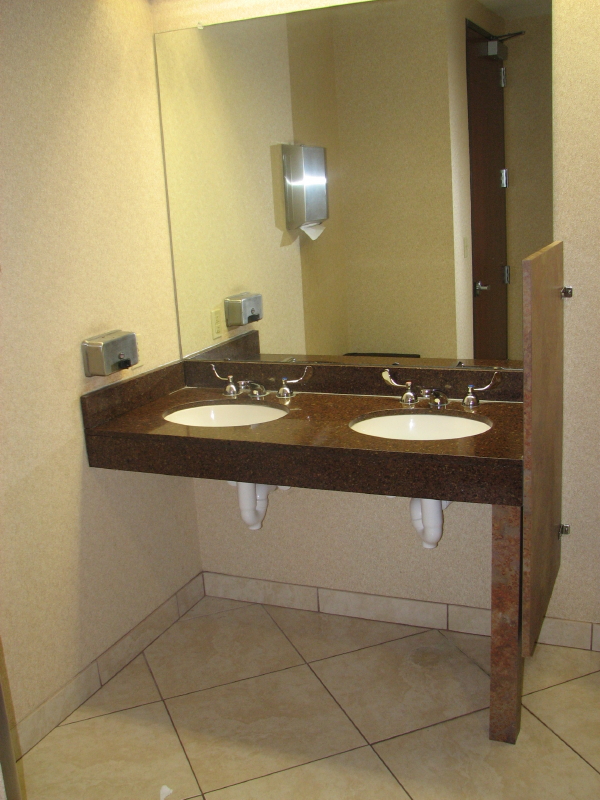
An Example of the Second Type of ADA Vanity with a Removable Angled Face and a Motion Sensing Faucet
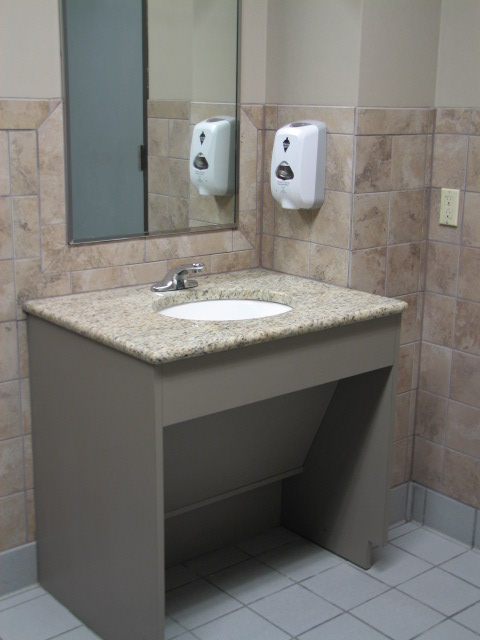
Regardless of whether there are special needs people working within a commercial building or not, we are required by law to make all the common areas ADA accessible. Homes provide a different situation when providing handicap home modifications because the alterations are put in place for specific full time occupants. The barrier free accessible route put in place must be observed as a means of life safety and function. You just never know when a personal life changing situation can appear requiring help for those with special needs. If one does occur we do have the means to offer aid and safety to those who have become afflicted in some unfortunate way and to help preserve their personal dignity and independence.
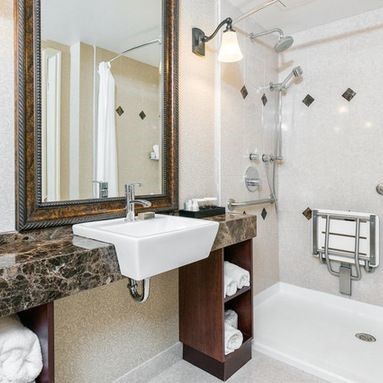

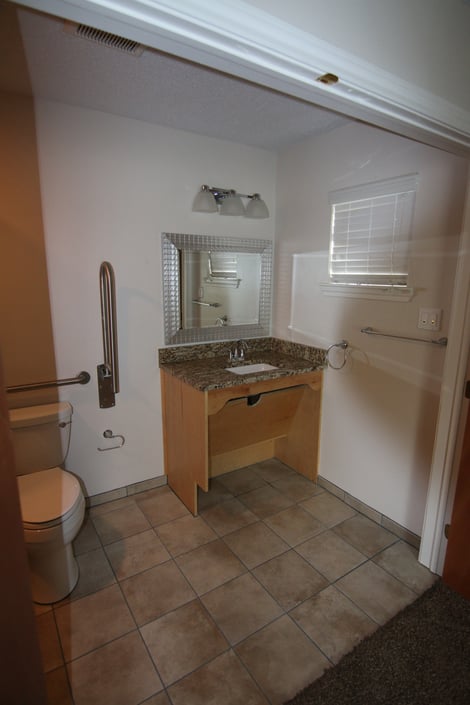
ADA Compliant Bathroom Vanities
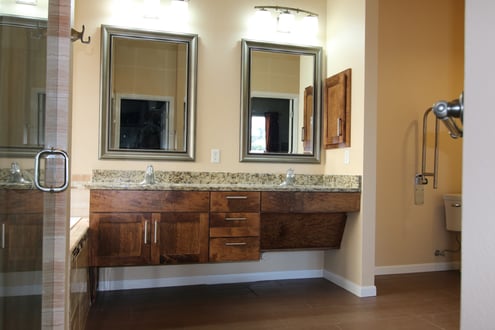
Tags:
Austin,
Texas,
how-to,
commercial cabinetry,
ADA accessible,
accessible routes,
ADA bathroom cabinets accessible routes,
ADA remodeling,
ADA bathroom cabinets,
ADA compliance,
ADA vanities,
ADA remodeling Austin, Texas,
ADA bathroom Austin, Texas
You either feel like the time has finally arrived for you to become self employed or you have been considering a larger work space because of your situation. You have been weighing out how to go about such a change. Once you have found a building and negotiated your lease it's time to find a reputable tenant improvement contractor who can help you through the construction process.
Austin commercial Tenant finishes can vary from merely a paint job to demolishing the entire space and starting over to better utilize the square footage. Utilization requires planning in advance and knowing all your business's operational needs. Work areas will always be defined per function. Storage areas, breakrooms, conference rooms, and reception areas should be considered so that the entire office flows well during hours of operation. Shipping can definitely be a consideration even if it doesn't play a major part in your business. Maybe your space is large enough to include the addition of private restroom facilities in addition to those located within the common area?
Work areas hold the most importance since they are tied directly to the income of the business. Private offices will be assigned as needed. Larger open spaces for setting up cubicles or multiple work stations can take up the majority of your new floor space. Storage areas for office supplies and even shipping areas will take up space as needed by the tenant according to the type of business.

Breakrooms need to be sized according to the number of people using the facility at any one time. All care should be taken for providing ADA accessible routes throughout any of the shared usage areas. ADA compliant kitchen cabinets should be used within the break area that provide sink space at the proper height above the finished floor and the proper clearances with protection below the sink area. If you were fortunate enough to have private restroom facilities installed be sure they fall within ADA compliance. Special vanity and fixture requirements for height, clearance, and reach must be observed throughout the restroom. You never know when you might hire a person with special needs.
Conference rooms can be placed either off to the side or within the very center of your space. Ceiling,floor, and wall treatments can be upgraded here because they will help define this room as being special. Installing commercial window walls or even half glass walls can highlight any conference room within your space and still provide privacy for business meetings. Window treatments like blinds or drapes can be added to increase the room's privacy when needed. Be sure to prewire for any devices used during presentations and don't forget about controlling the room lighting.
Reception areas make the first impression on the people coming into your office for the first time. Careful consideration must be given to their presentation. Are there enough seats for the amount of people who will drop by at any one time? Are there accessible writing surfaces for anyone who enters even if they are in a wheelchair? Does the room provide comfort to those who are waiting for an appointment? Remember this room could set the tone for a very important future meeting involving your business.
Be sure you get the experienced help you need and always hire a local office construction company to help you make the decisions that will need to be made in order to have a successful project.
A Private Office Built For Comfort
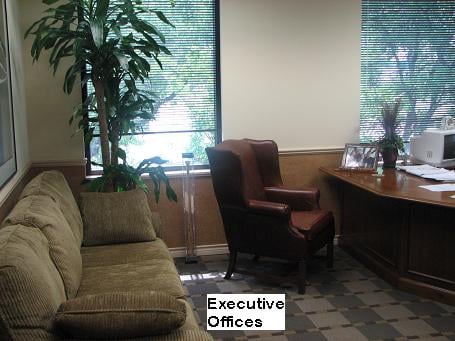

Tags:
Austin,
Texas,
how-to,
ADA compliant kitchen cabinets,
Commercial Construction,
tenant finish outs,
window walls,
ADA accessible,
accessible routes,
ADA bathroom cabinets accessible routes,
ADA bathroom cabinets,
tenant improvement contractor,
ADA vanities,
ADA bathroom Austin, Texas,
tenant finish Austin Tx,
tenant improvements in Austin,
tenant improvement contractor Austin, Texas,
tenant modifications Austin, Texas,
tenant finish contractors Austin, Texas,
Austin tenant finish
When dealing with any aspect of Austin commercial construction always hire a construction professional who has the experience needed to see through the gray parts of any design ideas. A very good tenant improvement contractor like T-Square Company can help with the functionality of your new commercial cabinetry. Focusing on only one idea a paid designer furnishes won't solve the function of the commercial cabinetry project. Experience goes well beyond the primary idea presented in the line drawing. You need help in order to know what parts of the design need to be and can be tweeked so that the total function of the commercial cabinetry can be realized.
Whether you are dealing in commercial bathroom remodeling, breakroom upgrades, or are in the need of an interesting reception desk you will need the help of a reputable commercial contractor. Every design that will be located within the common area must follow ADA rules for accessibility. Service desks should have designated areas with lowered heights and roll under capabilities to serve the people with special needs. Any commercial cabinetry not located within the common area can take on standard heights and depths.

Commercial cabinetry and commercial office cabinets in Austin, because of the increased use, must pass the durability test. Many people use and are constantly around pieces like reception desks and the traffic must flow well. All surfaces must be durable and be able to take a pounding. Proper drawer guides must be adequately matched with drawer content weight. Shelf brackets should also fit the weight of the materials they are holding up. Counter tops must be tough but look sharp. Reach limits must be realized and comfortable so that the user never has to leave his or her chair.
Before you hire a commercial construction company in Austin, Texas be sure you know their capabilities so that you can trust their judgement. Your project will go smoother when you can fully rely on your chosen qualified commercial builder.
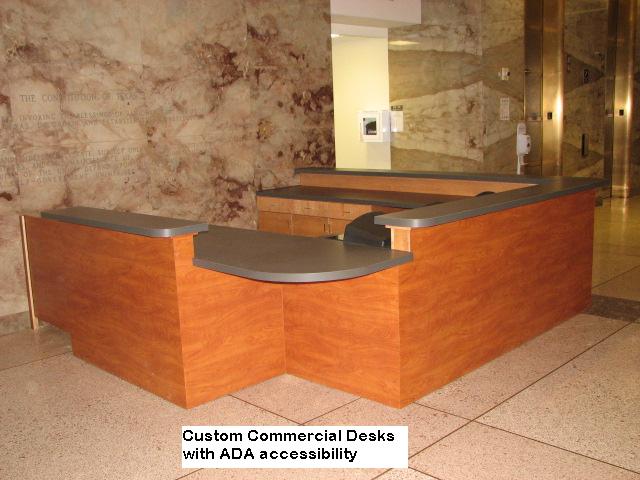
Tags:
Austin,
Texas,
how-to,
fine cabinetry,
commercial cabinetry,
ADA compliant kitchen cabinets,
Commercial Construction,
ADA accessible,
accessible routes,
ADA bathroom cabinets accessible routes,
ADA remodeling,
ADA bathroom cabinets,
ADA compliance,
ADA kitchen cabinets,
ADA vanities,
accessibility designs Austin Texas,
Austin commercial office cabinets,
commercial office cabinetry,
commercial office cabinets,
Austin commercial office cabinetry,
commercial cabinets Austin,
commercial office cabinetry in Austin,
Austin office cabinetry,
Austin office cabinets

































